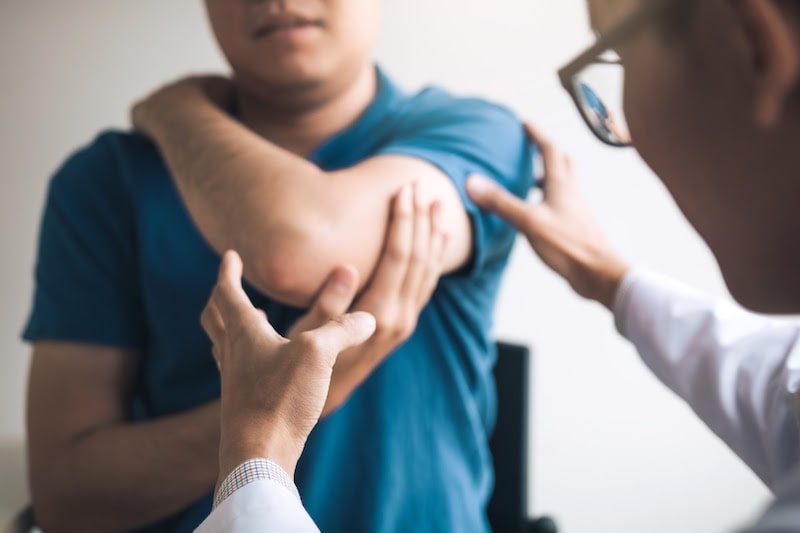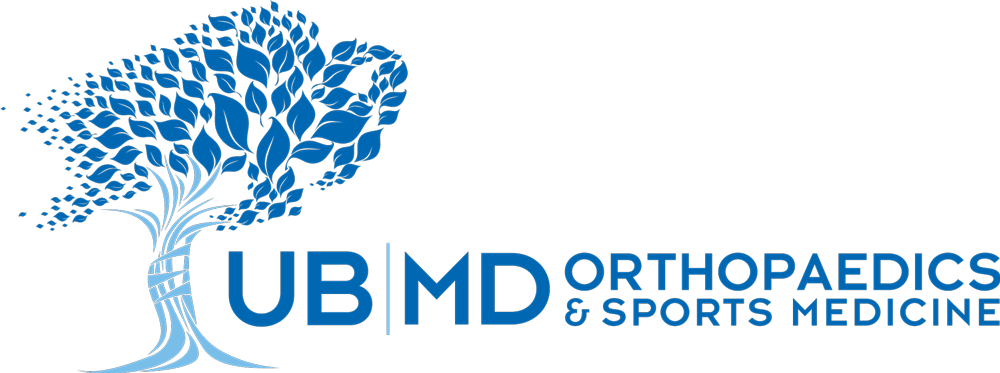
Elbow
The elbow is a complex joint that helps move and position your hand. This vital joint is also a meeting place for many different bodily systems, meaning that there are several conditions that can cause elbow pain including tendonitis, arthritis, fractures and instability.
At UBMD Orthopaedics & Sports Medicine, our board-certified physicians are experts in both operative and non-operative treatments for elbow conditions. They will tailor a specific plan to meet your unique needs.
Our staff specializes in the treatment of the following elbow problems:
- Arthritis
- Dislocation
- Golfer’s Elbow
- Fractures
- Impingement
- Inflammation
- Instability
- Nerve Compression
- Osteoarthritis
- Tendonitis
- Tennis elbow
It all starts with an examination and diagnostic testing, which may include X-rays or other tests. Once your physician has the most complete picture possible, they will put together a comprehensive approach to helping you recover physically, reduce or eliminate pain and allow you to return to your normal activities.
Get even more information on elbow-related injuries from the American Academy of Orthopaedic Surgeons, or give our team a call today to schedule an appointment.

Proud Sponsor of Buffalo’s 2024 National Shoulder & Elbow Week Event
With a Special Presentation Honoring Dr. Philip Stegemann
Schedule an appointment now
Patient Testimonials
“I really appreciate the attitude and care I have received AT UBMD. Dr. Bernas and Travis are very caring and listen to what you have to say. They care about their patients.”
“They took me in very quickly for x-rays, and I didn’t wait long until they brought me in a room to see the doctor. Dr. DiPaola was very knowledgeable, listened to me and my concerns, and came up with a plan. Everyone was very professional. I would definitely recommend them.”
“Dr. Ablove was amazing, wonderful, understanding, and outstanding! He took the time to explain the issues and how to best treat my problem. Thank you, Dr. Ablove, for being an incredible physician.”
Frequently Asked Questions About Elbow Pain
Blank
What are the common causes of elbow pain?
Elbow pain can result from various conditions, including:
- Tennis Elbow (Lateral Epicondylitis) – Overuse injury affecting the outer elbow.
- Golfer’s Elbow (Medial Epicondylitis) – Overuse injury affecting the inner elbow.
- Bursitis – Inflammation of the bursa (fluid-filled sac) in the elbow.
- Arthritis – Osteoarthritis or rheumatoid arthritis can cause joint pain.
- Fractures or Dislocations – Injuries due to falls or accidents.
- Nerve Compression (Cubital Tunnel Syndrome) – Pinched ulnar nerve causing pain and tingling.
When should I see a doctor for elbow pain?
You should seek medical attention if:
Persistent or Worsening Pain
- Pain lasts more than a few weeks, despite rest and home treatments.
- The pain is getting worse instead of improving.
Mobility or Weakness
- Difficulty bending, straightening, or rotating the elbow.
- Weakness in your grip strength or difficulty holding objects.
Numbness, Tingling, or Burning Sensations
- Symptoms in the hand, fingers, or forearm (may indicate nerve compression).
- Pins-and-needles sensation, especially in the ring and pinky fingers (could be cubital tunnel syndrome).
Visible Swelling, Deformity, or Bruising
- Significant swelling, lumps, or warmth around the elbow joint.
- A crooked or deformed appearance (possible dislocation or fracture).
- Large, deep bruising that spreads.
Pain After an Injury or Trauma
- Fell on your elbow or suffered a direct hit and now have severe pain.
- Hearing a popping or cracking sound during the injury.
Pain That Interferes With Daily Activities
- Struggling to carry, lift, or perform basic tasks.
- Discomfort while working, exercising, or sleeping.
No Improvement with Home Treatment
- Tried rest, ice, pain relievers, and physical therapy without relief.
- The pain keeps returning or flares up frequently.
Signs of Infection (If Post-Surgery or After a Cut/Wound)
- Redness, warmth, fever, or pus drainage from the elbow.
If you experience any of these symptoms, scheduling an appointment with an orthopedic doctor can help diagnose the issue and prevent long-term damage.
How is elbow pain diagnosed?
A doctor may use:
- Physical Examination – Checking for tenderness, swelling, and range of motion.
- X-rays – To identify fractures or arthritis.
- MRI or Ultrasound – To detect soft tissue injuries (ligaments, tendons, nerves).
- Nerve Tests (EMG) – To evaluate nerve compression issues.
What are the best treatments for elbow pain?
Treatment depends on the cause but may include:
- Rest & Ice – Reduce inflammation and prevent further strain.
- Pain Relievers – Over-the-counter NSAIDs (ibuprofen, naproxen).
- Physical Therapy – Exercises to strengthen muscles and improve mobility.
- Braces or Supports – Helps relieve strain on the elbow joint.
- Steroid Injections – For severe inflammation and pain relief.
- Surgery – In rare cases where conservative treatments fail.
Can elbow pain be prevented?
Yes, you can reduce the risk by:
- Warming Up Before Activity – Stretching before sports or workouts.
- Using Proper Technique – Especially in sports or repetitive tasks.
- Strengthening Forearm Muscles – Helps support the elbow joint.
- Taking Breaks – Avoid overuse by resting periodically.
- Using Ergonomic Equipment – Properly designed tools can prevent strain.
Is elbow pain always related to sports injuries?
No, elbow pain can also stem from:
- Repetitive Work Activities (e.g., typing, painting, using tools).
- Aging & Arthritis – Wear and tear over time.
- Medical Conditions (e.g., gout, nerve entrapment).
What home remedies can help with elbow pain?
- RICE Method – Rest, Ice, Compression, Elevation.
- Gentle Stretching – Helps maintain mobility.
- Topical Pain Relievers – Gels or creams with menthol or capsaicin.
- Massage Therapy – Can relieve tension in surrounding muscles.

